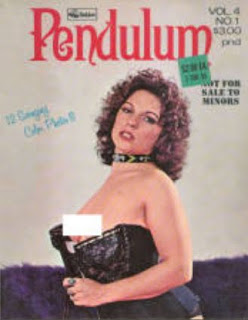 |
| Look at that girl with the Daisy Dukes on! |
NOTE: This article continues my coverage of Angora Fever: The Collected Short Stories of Edward D. Wood, Jr. (BearManor Bare, 2019).
 |
| Deuce, vol. 2, no. 3. |
The story: "Howl of the Werewolf," originally published in Deuce, vol. 2, no. 3, 1973. Also known as "Lust of the Werewolf."
Synopsis: Office secretary Rita Raleigh is spending her vacation in a remote cabin in the woods, despite her boss' warning. Once in the wilderness, all alone, Rita finds herself being kept up at night by the howling of wolves. She decides to make the long trip to the nearest village to purchase a gun. Because a pistol will require a few days, she decides to take a rifle instead. Back at her cabin, Rita is surprised when a handsome stranger named Kent Tenstyle enters her cabin, claiming to be stranded. She offers him whiskey, and they make love. But when the full moon appears, Kent becomes a snarling, savage werewolf! Rita tries to kill him with the rifle, but she realizes too late that she neglected to buy any silver bullets.
Wood trademarks: Werewolf (cf. Orgy of the Dead); nightgowns and negligees (cf. "The Responsibility Game"); affair with secretary (cf. The Cocktail Hostesses, "The Responsibility Game"); feeling a sudden chill over one's entire body (cf. Orgy of the Dead); cocktail lounge (cf. The Cocktail Hostesses, "Out of the Fog," "Never Fall Backwards"); "beer bar" (cf. "The Fright Wigs," "Starve Hell"); fur (in this case, a fur-covered chair, cf. "The Hazards of the Game"); whiskey (cf. "Starve Hell," "Never Fall Backwards"); "pubic region" (cf. "Exotic Loves of the Vampire"); focus on breasts and nipples (cf. "Gore in the Alley," "The Hazards of the Game," "The Hooker," "The Last Void," "Exotic Loves of the Vampire").
Excerpt: "Slowly she walked back to the bed and laid down. There was one thing she could think about which might take her mind off of the present situation. SEX was a powerful mind exploder. If anything could dismiss those howls, the thoughts of sex would be that entity."
Reflections: Ed Wood had a few different modes, so to speak, as an author. There's his gritty, down-and-dirty mode, as when he's documenting the lives of the desperately poor and hopeless. See "To Kill a Saturday Night" or "Mice on a Cold Cellar Floor" as examples. There's his lyrical, quasi-poetic mode, when his prose is formatted almost like verse. "Hellfire" and especially "I, Warlock" fit into this category. Then, there's Eddie's sadistic, gory, torture porn mode, when he taps into his own darkest and most violent fantasies. Think of "Breasts of the Chicken" or "Blood Drains Easily."
But then there is what I can only call Eddie's "high camp" mode. That's when he's at his most emotionally overheated and detached from reality. His dialogue in this mode tends to be very stilted and unnatural, his plotting surreal and dreamlike, and his word choices highly eccentric, verging on nonsensical. And it's all apparently unselfconsious or naive, with no perspective on itself. This is the highly quotable Ed Wood that people know best from movies like Plan 9 from Outer Space (1959) and Orgy of the Dead (1965). The guy who came up with stuff like "Torture! Torture! It pleasures me!" and "It's tough to find something when you don't know what you're looking for."
Those who purchase Angora Fever may well be looking for "high camp" Eddie, and they'll find him in "Howl of the Werewolf." It's a great story for reading out loud and could even have made a very entertaining short film, provided that the filmmakers did not try to overplay their hand by intentionally hamming it up. See The Vampire's Tomb as an example of what not to do.
The only real dissonant note here arrives at the very end of the tale. Those familiar with Wood's writing will know that Rita Raleigh (some name!) is a goner the moment Kent Tenstyle (another great one!) shows up in her cabin. But the way Ed chooses to sexualize Rita's death very graphically, even having her climax in the last sentence, may turn the stomachs of modern day audiences. Was this story intended as a power fantasy for male readers who identified with the werewolf?
Next: "The Witches of Amau Ra" (1972)





























